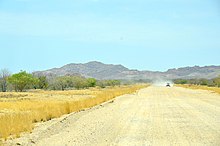gravel


Gravel is, on the one hand, a technical term in geosciences for natural, predominantly scree-bearing loose sediments and, on the other hand, a technical term in construction for coarse broken aggregates , in contrast to unbroken gravel .
Technical term of geosciences
In the geosciences, gravel describes an unconsolidated sediment that has a proportion of more than 50% rounded rock components with a grain diameter of more than 2 mm (so-called pebbles ) and is therefore synonymous with the sediment term gravel . Since it is not solidified, gravel is typical of geologically young, often Quaternary sediment bodies. The pebbles got their roundness through surface abrasion during frequent relocation in strongly moving water, primarily in streams and rivers ( fluvial gravel), through glacier melt water (glacifluvial gravel) or on coasts ( marine gravel). Gravel sediments hardened to form rock are called conglomerates .
In contrast to gravel, loose sediments, which predominantly have non-rounded rock components, are referred to as rubble . Material transported and deposited by glaciers, which typically mainly contains partially rounded ( rounded edges ) components, is called bed load . In fluvial morphology, hydrology , engineering geology and hydraulic engineering , river gravel is also referred to as "bed load".
Technical term in construction
In the construction industry, gravel is the term used to describe angular, broken minerals with a grain size between 32 and 63 millimeters, mostly for use in traffic route construction . (In the construction industry, round shapes of this grain size are not referred to as crushed stone, but as gravel ). Gravel is broken aggregate that is produced artificially or as waste in quarries or in crushing machines. Some of them are produced from naturally deposited loose sediments (river debris, glacier debris) in crushing plants.
Smaller aggregates are grit and crushed sand , larger aggregates are called Schroppen (also rubble , block rubble, rock decomposition). In the stone and earth industry, rock fractions of all sizes are commonly referred to as crusher products .
Use of crushing products
In road construction, ballast with graded grain sizes ( stone sizes) is used, among other things, for base layers of roads or with binding agents (for example bitumen as asphalt concrete or with cement and water as concrete or cement-bound base layer).
Gravel of different grain sizes can also serve as a frost protection layer underneath the paved road surface.
The term gravel is used to describe a specific aggregate . The technical delivery conditions for rock in road construction (TL Gestein-Stb) , which is usually used in public road construction, defines aggregates as granular material for use in construction, whereby aggregates can be natural, industrially produced or recycled.
The construction of railway tracks is known as a ballast bed is also ballasted called for antifreezing stabilization of the railway tracks. The installation of gravel called ballast .
In concrete ballast is as aggregate used.
See also
- Gravel bank
- Gravel road (water-bound cover)
Web links
Individual evidence
- ↑ a b Christiane Martin, Manfred Eiblmaier (Ed.): Lexicon of Geosciences. 6 volumes. Spectrum, Akademischer Verlag, Heidelberg et al. 2000-2002, ISBN 3-8274-1655-8

